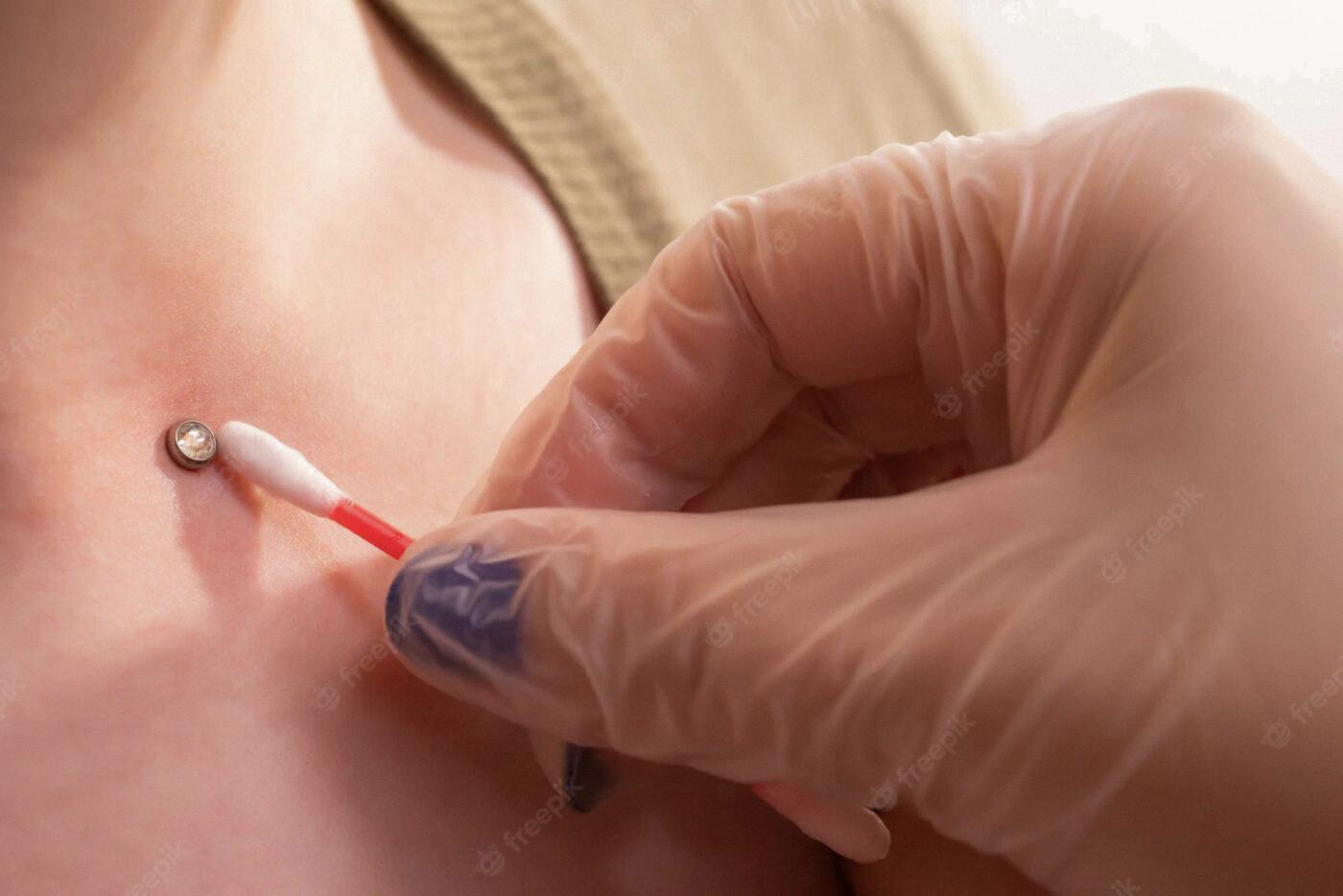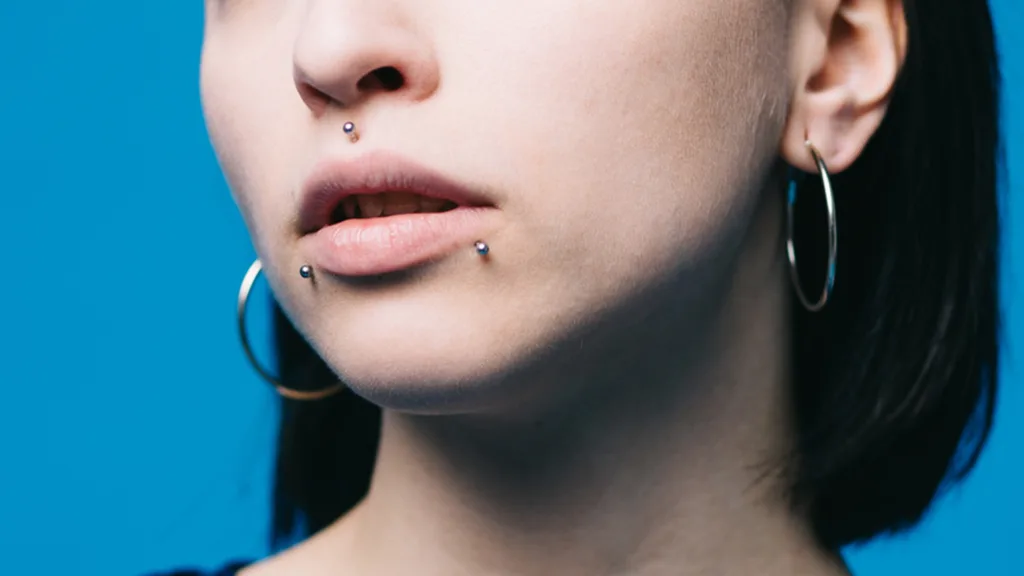Dermal piercings, also known as microdermal piercings or single-point piercings, are a type of body modification that involves the insertion of a small piece of jewelry into the skin. Unlike traditional piercings, which penetrate through two layers of skin, dermal piercings are anchored in place with a single anchor or base that sits beneath the surface of the skin.
The process of getting a dermal piercing involves several steps. First, a professional piercer will sterilize the area where the piercing will be placed. Then, they will use either a dermal punch or a needle to create a small pocket or hole in the skin. Using dermal forceps, the piercer will then insert an anchor with either a footed or round base into the area.
Once the anchor is in place, the piercer will attach a piece of jewelry to the top of the anchor. This can be a stud, gemstone, or other decorative element. The jewelry can be changed over time, but the anchor itself should not be removed unless it is causing problems or needs to be replaced.
One of the advantages of dermal piercings is that they can be placed almost anywhere on the body. Common locations include the chest, back, wrists, and ankles, but they can also be placed on the face or neck. However, because dermal piercings are anchored beneath the skin, they tend to be more difficult to remove than traditional piercings.
One potential risk of dermal piercings is that they can become infected or rejected by the body. Because the anchor is sitting beneath the skin, it can be difficult to clean properly, and bacteria can easily become trapped inside. Additionally, the body may see the anchor as a foreign object and attempt to push it out, leading to rejection of the piercing.
To care for a dermal piercing, it is important to keep the area clean and dry. Thoroughly clean the area once a day, pat dry with a clean piece of paper towel, then apply a fresh Band-Aid. Avoid touching the piercing with dirty hands, and avoid swimming or soaking in water until the piercing has fully healed.
On average, dermal piercings take between one to three months to heal. During this time, it is important to be patient and to follow the aftercare instructions provided by your piercer. With proper care, a dermal piercing can last for several years before needing to be replaced or removed.
Dermal piercings are a unique and versatile form of body modification that can be placed almost anywhere on the body. While they come with some risks and require careful aftercare, they can be a beautiful and long-lasting addition to your personal style.
How Long Do Dermal Piercings Last?
Dermal piercings are a unique type of body modification that involves inserting an anchor beeath the skin’s surface to hold a decorative piece of jewelry in place. The longevity of a dermal piercing depends on various factors, such as the location of the piercing, the aftercare routine, and your body’s natural healing ability.
Generally speaking, a well-maintained dermal piercing can last anywhere from six months to several years. However, it’s essential to note that dermal piercings are not permanent and will eventually grow out. The skin’s natural healing process will push the anchor up to the surface over time, causing the piercing to fall out.
To ensure the longevity of your dermal piercing, it’s crucial to follow a strict aftercare routine. This includes cleaning the piercing daily with saline solution or a mild soap and avoiding activities that may put pressure on the piercing, such as sleeping on it or wearing tight clothing. Additionally, it’s essential to avoid changing the jewelry too often, as this can irritate the piercing and increase the risk of infection.
A dermal piercing can last anywhere from several months to a few years, depending on how well you care for it. While dermal piercings are not permanent, they can be a unique and stylish addition to your body mod collection with proper care and maintenance.

Source: studentbeans.com
The Pain Level of Dermal Piercings
Dermal piercings, also known as microdermal piercings or dermal anchors, are a type of body piercing that involves inserting a small, flat base beneath the skin, with a post or loop protruding from the surface of the skin. Although the pain level associatd with dermal piercings can vary depending on the location of the piercing, most people report a pain level of around 3 out of 10.
It’s important to note that pain tolerance varies from person to person, and some individuals may find the piercing to be more painful than others. Additionally, the pain experienced during the piercing process may also depend on the experience and skill level of the piercer.
The healing time for dermal piercings can take between one to three months, depending on various factors such as the location of the piercing and the individual’s overall health. During the healing period, it’s important to follow proper aftercare instructions to avoid infection and promote healing.
After the piercing, it’s recommended to thoroughly clean the area once a day with a saline solution or mild soap and water. It’s important to pat the area dry with a clean piece of paper towel and avoid using cloth towels as they may harbor bacteria. Applying a fresh Band-Aid or sterile gauze can help protect the area and prevent irritation.
While dermal piercings may cause some pain during the piercing process and healing period, many people find the end result to be worth it. As with any body modification procedure, it’s important to do your research and choose a reputable and experienced piercer to minimize the risks and ensure a successful outcome.
Insertion of a Dermal Piercing
A dermal piercing, also known as a transdermal implant, is a type of body modification where an anchor is placed under the skin, providing a base for jewelry to be attached to. The process of inserting a dermal piercing involves several steps.
Firstly, the area where the piercing will be inserted is cleaned and sterilized. This is to prevent any potential infections from occurring dring the procedure. The piercer will then use a dermal punch or a needle to create a small hole in the skin.
If a dermal punch is used, a small tube of flesh is removed. If a needle is used, an L-shaped pouch is created under the skin. The piercer will then use dermal forceps to insert the anchor into the area.
There are two types of anchors that can be used for dermal piercings: footed and round base. A footed anchor has a flat base with two or more feet that help to distribute the weight of the jewelry. A round base anchor has a circular base that sits under the skin.
Once the anchor is in place, the piercer will attach the jewelry to the top of the anchor. The jewelry can be changed at any time, but the anchor should be left in place to prevent any damage to the surrounding tissue.
It is important to note that dermal piercings require proper aftercare to prevent infection and promote healing. The piercer will provide instructions on how to care for the piercing, including cleaning and avoiding certain activities for a period of time after the procedure.
A dermal piercing is inserted by cleaning and sterilizing the area, creating a hole in the skin, inserting an anchor with dermal forceps, and attaching jewelry to the top of the anchor. Proper aftercare is necessary to ensure the piercing heals correctly.

Conclusion
Dermal piercings are a unique and versatile form of body modification that can be placed almst anywhere on the body. They require proper care and attention to ensure they heal properly and last as long as possible. While the exact timeline for a dermal piercing varies from person to person, with proper aftercare, they can last for several years. It’s important to get your dermal piercing done by a professional piercer who uses sterile equipment and follows proper safety procedures. With the right care and attention, a dermal piercing can be a beautiful and unique addition to your body art collection.
